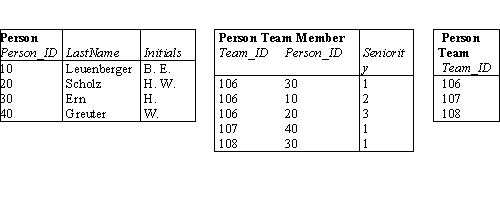
It may be reasonable for a specific database implementation to choose a less elaborate model for person, and person team data, than the one depicted in fig. 1. A common method to reference person teams in database tables is to enter the entire team as a concatenated string of persons. This method has the advantage of easy implementation and good performance, but no quality control is maintained and a considerable amount of redundant data are introduced. The introduction of a separate person team table reduces redundancy on the team level, although the individual person is still repeated for any team she occurs in. A person table can be used as a quality control measure only, by forcing the user to compose the team string in the team table from individual person names, however, referential integrity cannot be maintained (e.g. deleting a person does not affect a person team it is a member of). Since teams are often composed of shortened version of the persons' names (use of initials, taxonomic author abbreviations, etc.), the individual designation of a member may not be unique. Later changes trying to remedy that situtation cannot be automated but need expert revision - e.g. the change in abbreviation standards for taxonomic authors (Halliday & al. 1980, Brummitt & Powell 1992). An additional disadvantage of the approach lies in the different formats of the person team string which may be required (e.g. author citations in journals, taxon author citations).
For these reasons, in the IOPI and CDEFD data models the teams are actually composed by the persons present in the person table, thus representing a relational structure of person teams adhering to the third normal form as defined by Codd (1979). Every person exists only once in the database, and every format required can directly be retrieved from the person table. Errors resulting from inconsistencies of the underlying person data may be corrected without further effort, and the referential integrity features of the database management system (DBMS) may be used to maintain data integrity. The data are stored in the 3 tables involved in the person team construct as follows:

Fig. 2: Tables used to compose person teams
The Person Team Member table to the right defines team no. 106 as "Ern, H., Leuenberger, B. E. & Scholz, H. W." while team no. 107 consists of a single person ("Greuter, W.")